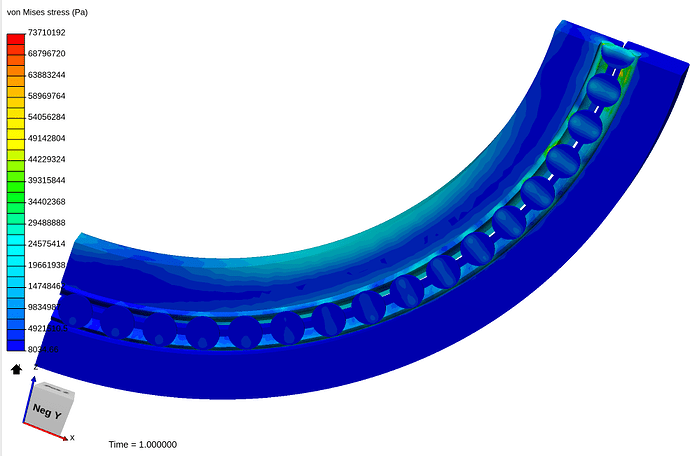Greetings!
I am having problems trying to conduct a static analysis of a wire race bearing. I set up boundary conditions, geometry and other settings, but cant seem to get simulations running. I always get a simulation error.
Project: SimScale
Thank you for your help
Kind regards,
Jurij
Hi Jurij!
Thanks for the project link! Give me some time to have a look at your project, will get back to you as soon as possible.
Best,
Jousef
1 Like
Hi @jgrguric,
I had a look at your project. There were basically 2 isues that prevented your run to be successful:
- First, you used too few cores (only 4) such that not enough memory was available. The mesh has already 80K nodes, but more importantly you have a lot of nodes assigned to physical contacts, which adds additional unknowns to the system. Using 8 or 16 cores should work.
- secondly, you used a symetry BC represent the half-symmetry of your model, which is in general OK, but in this case leads to an error. The symmetry BC can sometimes cause over-constraint systems when there are shared nodes between this and other constraints. Here you can simply replace the symmetry constraint with an equivalent fixed value constraint by constraining only the Y-direction.
With these two changes the simulation runs successfully, as you can see in my copy of your project here: https://www.simscale.com/workbench/?pid=8994650407617400492&mi=run%3A6%2Csimulation%3A1&mt=SIMULATION_RUN
Finally, you are using a constant load via a remote force, which is not recommended in a nonlinear analysis. In order to improve/allow the convergence you should generally always ramp your applied loads either via a formula or table value. I applied a linearly increasing force and started another run (I have to admit that in this case it’s actually not faster than the constant load application setup and might even time out): https://www.simscale.com/workbench/?pid=8994650407617400492&mi=run%3A7%2Csimulation%3A1&mt=SIMULATION_RUN
(you got actually lucky that in your initial run the first time step already converged, otherwise the run would have failed as the automatic time stepping has no effect on a constant load).
The results look reasonable, but I guess there is always some room for improvement (try to reduce the elastic supports, improve the mesh, result independence from penalty factors):
Best,
Richard
4 Likes
Thank you @rszoeke for explanation, you are showing great community spirit and knowledge. I will try to dig deeper and improve the simulation, this was mainly just a test to try out this software. Keep up the good work guys!
1 Like
Great that I could help you @jgrguric!
Looking forward to your “real” projects.
Best,
Richard
2 Likes

